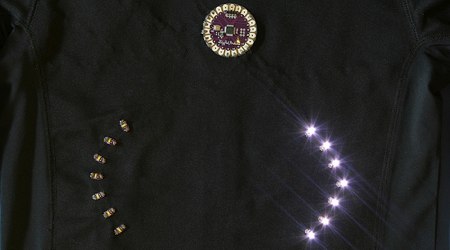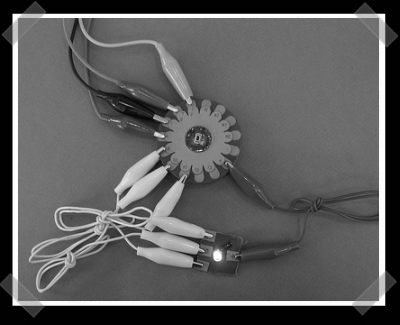Our favorite electric textiles expert, [Leah Buechley], put together this machine embroidered LED matrix proof of concept. For the vertical rows, the top thread is conductive, while the thread on the underside (the bobbin) is not. For the horizontal rows, the the thread is swapped and the fabric acts as an insulator between the two layers of wiring. You can see a small brown bunch of thread next to each LED: this is the via to wiring on the backside of the fabric. The matrix is being controlled by a LilyPad Arduino. This is an interesting idea and has the potential to make prototyping wearable projects much faster. Here are two more pictures of the project.
leahbuechley3 Articles
Turn Signal Jacket How-to

[Leah Buechley], whose work we’ve been covering since way back when, has built this lovely turn signal jacket. The project photos were posted in March, but she’s just added a well illustrated project guide. The jacket is based around a LilyPad Arduino, a lightweight Arduino board with radial pads designed to be used in wearable projects. You make your connections by sewing conductive thread through the pads. The how-to covers attaching the LilyPad parts properly and then insulating the wires with fabric paint after you’ve verified they work.
The guide has an interesting discussion about placing the power supply. The 4-ply silver coated thread used has a resistance of approximately 14ohms/foot. So, if you place the power supply one foot from the LilyPad, the two wires combine for 28ohms, causing a 1.4V drop. The power supply is only 5V, which means the LilyPad will be 3.6V. A voltage of 3.3V will cause the Arduino to reset. If your resistance is too high, you’ll have to add more thread.
The power supply on this jacket is under the collar. Each cuff has a single button plus an LED. The button will make the jacket flash the direction for 15 seconds (also indicated on the sleeve LED). If you press both buttons at the same time, it switches to night mode by flashing both directions at the same time to make you more visible.
Interactive Textile Construction

The e-textile construction kit by [Leah Buechley] consists of stitch-able sensors and microcontrollers. Stitch-able refers to the fact that these parts can be sewn with a needle and thread into wearable clothing or other fabric-based housings. A paper (PDF) on the e-textile construction kit project contains the first version. The second version of the e-textile construction kit, the LilyPad Arduino, is available this month through SparkFun’s site. Especially interesting are her instructions for modifying the clock speed on the Arduino to make it suitable for battery powered wearables.
We’ve covered [Leah Buechley]’s work twice in 2005 for her wearable led matrix work.
Update: [Leah] updated her site since we posted this and added this new how-to.









